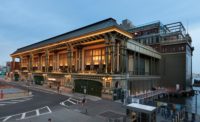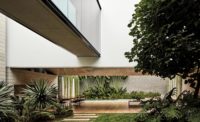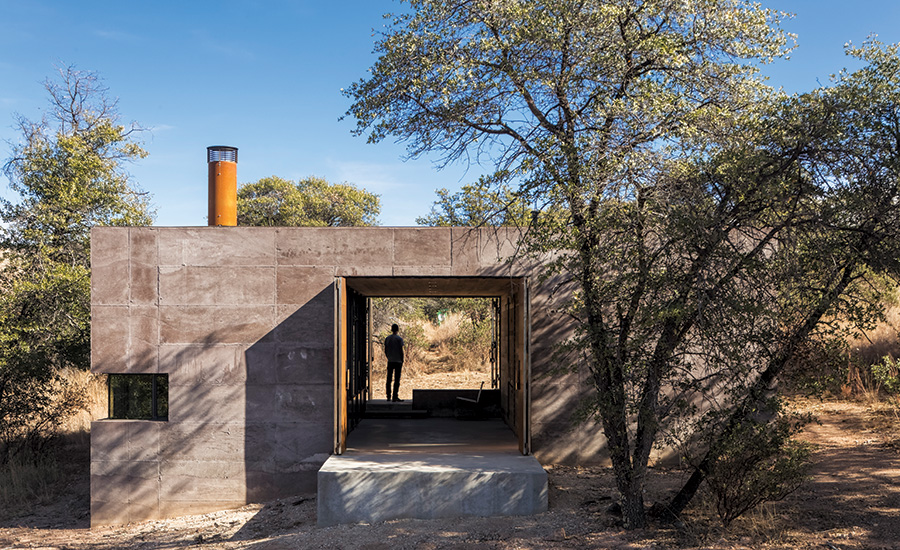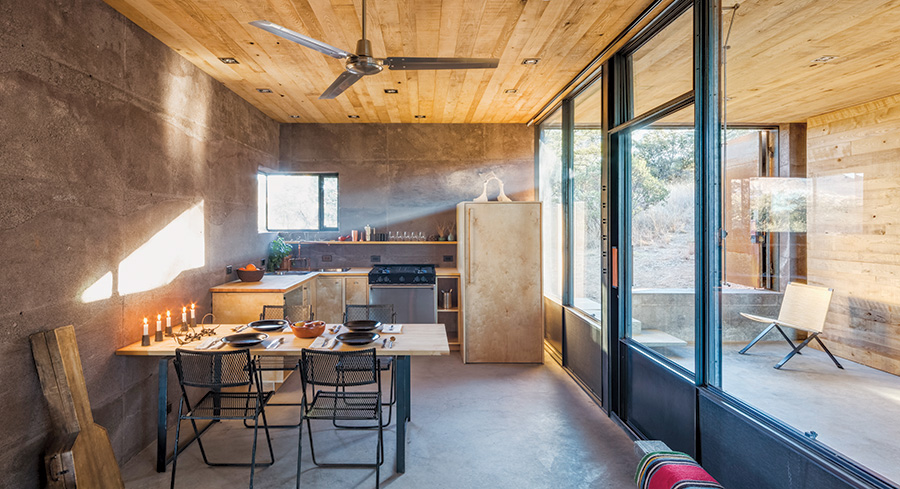Casa Caldera by DUST
San Rafael Valley, Arizona

Casa Caldera
Casa Caldera’s monolithic form is made of a volcanic aggregate similar in color to the surrounding terrain, blending into the landscape. Designed to minimize solar gain and maximize airflow, the self-sustaining house has small windows and a zaguán, or central entry corridor that circulates cross breezes through the interior when its bifold doors are open.
Photo © Jeff Goldberg/Esto

Casa Caldera
Casa Caldera’s monolithic form is made of a volcanic aggregate similar in color to the surrounding terrain, blending into the landscape. Designed to minimize solar gain and maximize airflow, the self-sustaining house has small windows and a zaguán, or central entry corridor that circulates cross breezes through the interior when its bifold doors are open.
Photo © Jeff Goldberg/Esto

Casa Caldera
Reclaimed rough-sawn sassafras clads ceilings and the wall of the private zone. DUST designed and fabricated the home’s fenestration, hardware, and furnishings, including the steel doors and framing for the windows and glass zaguán wall.
Photo © Jeff Goldberg/Esto

Casa Caldera
Reclaimed rough-sawn sassafras clads ceilings and the wall of the private zone. DUST designed and fabricated the home’s fenestration, hardware, and furnishings, including the steel doors and framing for the windows and glass zaguán wall.
Photo © Jeff Goldberg/Esto

Casa Caldera
Perfectly sited to frame sunsets, the zaguán doubles the comfortable living area and extends onto a west-facing patio.
Photo © Jeff Goldberg/Esto

Casa Caldera
Site Plan.
Image courtesy DUST

Casa Caldera
Floor Plan.
Image courtesy DUST

Casa Caldera
The zaguán doubles the comfortable living area. DUST created a bench adjacent to the entrance stairs to accommodate the steep grade on the building’s east side.
Photo © Jeff Goldberg/Esto

Casa Caldera
Casa Caldera’s 265-sqaure-foot private zone, which is heated by a wood stove, contains two small bedrooms and a compact bath with sliding steel doors.
Photo © Jeff Goldberg/Esto

Casa Caldera
The internal bedroom walls and ceilings are surfaced in plywood.
Photo © Jeff Goldberg/Esto

Casa Caldera
The private zone is on the south side of the house. Each room has one operable window.
Photo © Jeff Goldberg/Esto

Casa Caldera
Each window has been outfitted with thin, removable security bars, so discreet that they seem to be part of the aesthetic.
Photo courtesy DUST

Casa Caldera
Each window has been outfitted with thin, removable security bars, so discreet that they seem to be part of the aesthetic.
Photo courtesy DUST

Casa Caldera
Corner windows frame the views.
Photo courtesy DUST

Casa Caldera
The weathering steel doors are sealed shut on cold nights and when the owner is away.
Photo courtesy DUST

Casa Caldera
The weathering steel doors are sealed shut on cold nights and when the owner is away. To accommodate the steep grade the design/build firm devised a man door.
Photo © Jeff Goldberg/Esto

Casa Caldera
Removing the forms.
Photo courtesy DUST

Casa Caldera
A layer of foam insulation was placed within the scoria mix about 6” from the façade.
Photo courtesy DUST

Casa Caldera
The scoria being delivered to the site from northern Arizona.
Photo courtesy DUST



















Architects & Firms
Overlooking Arizona’s expansive San Rafael Valley, at an elevation of 5,000 feet, the tiny house known as Casa Caldera doesn’t provide the easy escape of a typical vacation getaway. What this 1,060-square-foot, off-the-grid retreat does deliver are stunning views and the opportunity for an adventure that begins with getting there. Roughly half of the two-hour drive southeast from Tucson cuts through mountains and goes off-road, across spectacular high-desert grasslands, past grazing cattle, and up into forested slopes.
Additional Information:Video
People/Products
The earth-hued house was built with scoria, a porous cementitious material, also referred to as lava concrete, that takes its name from its primary component, a lightweight volcanic cinder, similar in color and makeup to the surrounding terrain. (Geologically, the region was once the site of a caldera, or large volcanic crater.) The building is not visible from the road. Tucked just below the crest of a hill and camouflaged by Emory oaks, Casa Caldera emerges from the landscape slowly, but only after you park your vehicle at an informal “carport” and activate the house’s sources of electricity and hot water—a self-contained portable solar system and a propane tank.
The enigmatic site and gradual approach to it were calculated by architect Cade Hayes and his partner Jesús Robles, principals at the Tucson-based design/build firm DUST, to heighten the anticipation of arrival. It also satisfies the client’s brief for a secure, discreet home that won’t disturb the viewshed of neighboring properties.
An adventurous Ohio-born winemaker who counts falconry as one of his hobbies, the 40-something owner purchased the land from family planning to sell the remains of a larger ranch. His budget was modest, his needs simple: a modern, self-sustaining refuge, with outdoor space, where he could commune with nature and plant a small vineyard for pleasure. Because the house would be left empty for long periods of time, he also wanted the ability to shut it down when he was away.
Given the remote location and budgetary limitations, the designers convinced the client that building with scoria would be the best option for the project. The construction process is similar to rammed earth, a system DUST had employed for its first house (Tucson Mountain Retreat, record, April 2013, page 72), but it is less expensive and has superior thermal properties due to its porosity. Additionally, because it is less dense, scoria can be easily reinforced with rebar as needed.
Hayes and Robles responded to the Southwest vernacular with a contemporary variation of a traditional Spanish Colonial Zaguán house. According to Hayes, this compact style, bisected by a central corridor (or zaguán) that leads from entrance to patio, would be easy to close up. “But we were also thinking about ventilation,” he says. Since the house would have no mechanical cooling or heating, insulation and cross-ventilation were key factors in the scheme. The zaguán creates a pressure differential. “So as long as you have access to cool breezes, it will pull the air through,” Hayes explains.
The one-story monolithic structure, slightly off axis to capture views, is sited to benefit from airflow and solar heat gain. The zaguán was configured with rugged weathering-steel bifold doors at either end, which can be left wide open to extend the living space in good weather or shuttered. The crew added a layer of foam insulation within the building’s 18-inch-thick scoria walls and installed five operable windows, set half-way back into the facade for shade. Thin, removable steel bars, horizontal rather than vertical, add an almost decorative layer of security without being obtrusive.
“The openings are small. We didn’t go for the architectural move of a skylight,” says Robles. “And we resisted any temptation to make design decisions just for an aesthetic. Everything is rooted to function.” Still, a west-facing corner window, positioned to bring in plenty of daylight, frames a mountainous panorama. Adjacent young trees will prevent glare when they are fully grown. To water them, DUST devised a central gutter for the standing seam metal roof that directs rainwater down through the building and out toward their roots. The house is fed by a natural well, but irrigation in this semi-arid clime can be an issue, so even the septic system was configured to filter cleansed water into the rocky soil around saplings.
The interior is split into three zones, about 270 square feet each. The 10-foot-wide zaguán is bordered by enclosed public and private wings and opens onto a west-facing concrete patio, a place to enjoy the amazing sunsets. Wood is the primary heat source: a fireplace for the kitchen/ dining/living room and a wood stove for the bed and bath area opposite, while a ceiling fan, transoms, and operable kicks (on a glass wall between the living and zaguán spaces) circulate the air.
The owner looks forward to spending months at a time at Casa Caldera. “My dream is to be there for several months in the fall. I can forget about the rest of the world, but it is only an hour and 40 minutes to an international airport,” he says. “It’s pretty special.”
PeopleArchitect: DUST - Cade Hayes, principal/project architect; Jesús Robles, principal/project manager
General Contractor DUST Jesus Robles, Project Manager Cade Hayes, Project Manager Jay Ritchey, Carpentry Agustin Valdez, Concrete and Masonry
Engineer: David Gibbens (structural)
Consultants: Lava Works Concrete - Paul Schwam (scoria); Eternity Electricity (electrical)
Photographer: Esto/Jeff Goldberg 222 Valley Pl, Mamaroneck NY 10543 914.698.4060
Client: withheld
Size: 1,060 square feet
Cost: withheld
Completion Date: December 2015 |
ProductsStructural System Scoria Walls built by DUST Consulting: Paul Schwam of Lava Works Concrete 520.250.0522
Roofing Standing Seam Flashings INC. Tucson, Arizona Dave Dean 520.629.8884
Wood Resource and Milling Baer Joinery 925 S Mill Street Tucson AZ 85719 520.358.0911
Photovoltaic System Sacred Power Solar Skid 1501 12th St NW Albuquerque, NM 87104 505.242.2292
Unique Products that Contribute to Sustainability Kimberly Wood Stove No Heating or Air Conditioning Water from a well
Other Sources Metal frame windows: Custom steel frame windows by DUST Glass: Oldcastle BuildingEnvelope (Insulated Low E) Doors: Custom DUST Entrances: Custom DUST Metal doors: Custom Bi-folding Metal Doors DUST Wood doors: Custom DUST Sliding doors: Custom DUST Locksets: Accurate Mechanism Pulls: Custom DUST Cabinetwork and custom woodwork: Custom DUST Wall coverings: Reclaimed Roughsawn Sassafrass at the living spaces, Birch Ply in the bedrooms. Plaster in the bathroom Floor: Concrete – Agustin Valdez Chairs: DUST Tables: DUST Downlights: Bazz Dimming System or other lighting controls: House of Antique Hardware Plumbing: Custom Copper DUST (There were no plumbing fixtures as they are all copper pipe with industrial shut off valves.) Electrical: Eternity Electric LLC, Sam Rojas. Tucson Arizona Kitchen sink and bathroom sink: IKEA Tankless gas water heater: Rennai Propane Refrigerator: Crystal Cold Propane Range: Premier (Pro Series) Toilet: Toto Washing Machine: Summit |
























